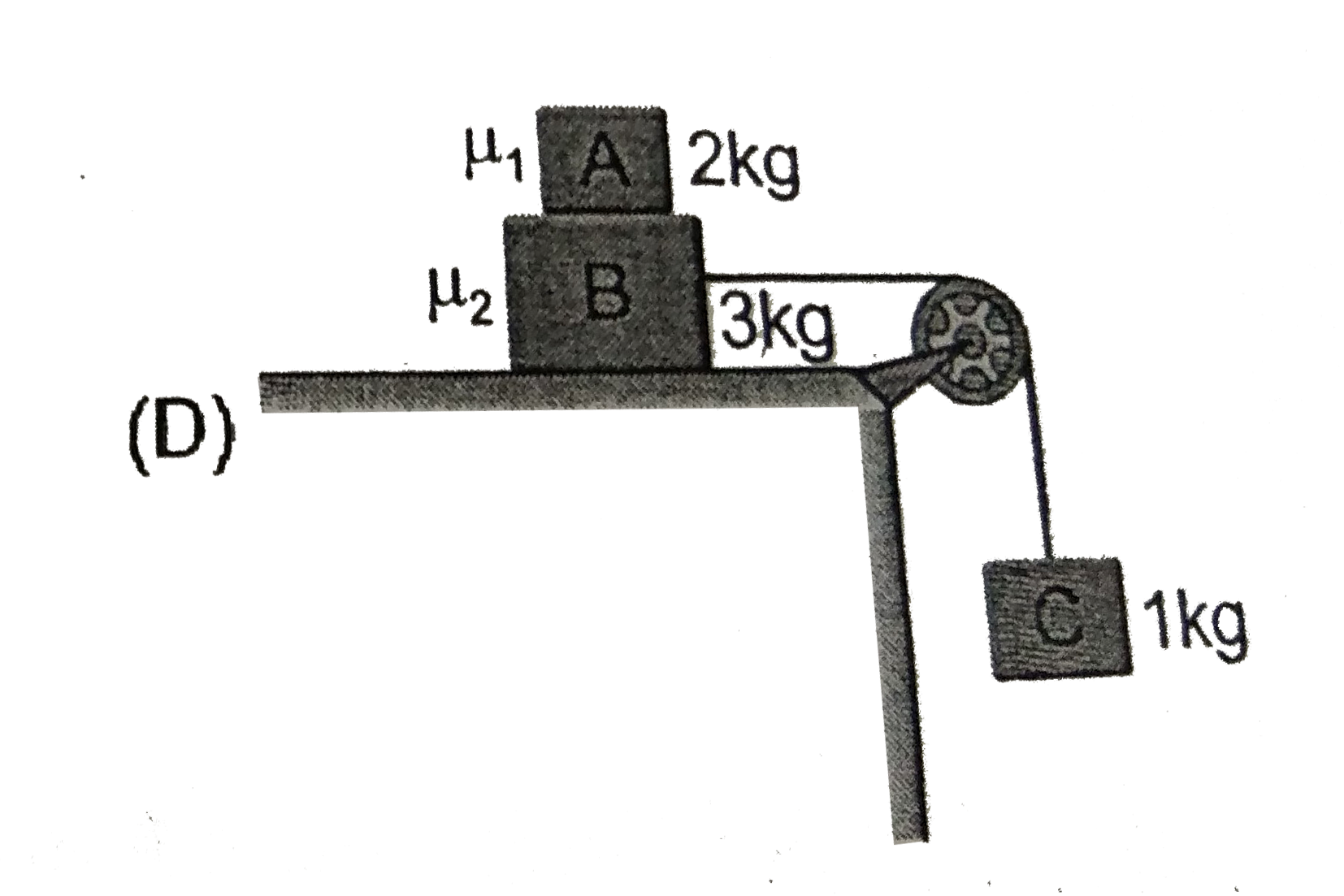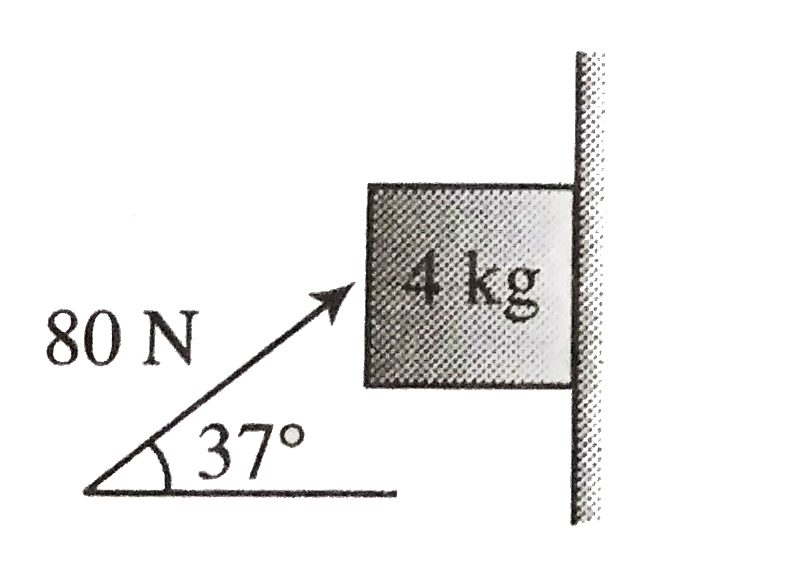In which of the following cases the friction force between 'A' and 'B' is maximum. In all cases μ1=0.5,μ2=0.




The correct Answer is:B
To determine in which case the friction force between blocks A and B is maximum, we can analyze each case step by step using the given coefficients of friction and the forces acting on the blocks.
Given:
- Coefficient of friction between A and B, μ1=0.5
- Coefficient of friction between B and the surface, μ2=0
Case Analysis:
Case 1:
- Block A (2 kg) is on top of Block B (3 kg).
- A force of 10 N is applied to Block B.
- The total mass M=2+3=5 kg.
- Acceleration a=FM=10N5kg=2m/s2.
- The normal force N acting on block A due to its weight is N=mg=2kg×10m/s2=20N.
- The friction force FAB=μ1N=0.5×20N=10N.
Case 2:
- Block A (2 kg) is on Block B (3 kg), which is inclined at 37 degrees.
- The normal force N=mgcos(37∘)=2kg×10m/s2×45=8N.
- The friction force FAB=μ1N=0.5×8N=4N.
Case 3:
- Block A (2 kg) is on Block B (3 kg), and B is fixed.
- The normal force N=mg=2kg×10m/s2=20N.
- The friction force FAB=μ1N=0.5×20N=10N.
Case 4:
- There are three blocks (A, B, C) with block A on top of B, and B is on C.
- The total mass M=2+3+1=6 kg.
- The acceleration a=10N6kg=53m/s2.
- The normal force N=mg=2kg×10m/s2=20N.
- The friction force FAB=μ1N=0.5×20N=10N.
Summary of Friction Forces:
- Case 1: FAB=10N
- Case 2: FAB=4N
- Case 3: FAB=10N
- Case 4: FAB=10N
Conclusion:
The maximum friction force between blocks A and B occurs in Case 1, Case 3, and Case 4, where the friction force is 10N.
- Coefficient of friction between A and B, μ1=0.5
- Coefficient of friction between B and the surface, μ2=0
- Block A (2 kg) is on top of Block B (3 kg).
- A force of 10 N is applied to Block B.
- The total mass M=2+3=5 kg.
- Acceleration a=FM=10N5kg=2m/s2.
- The normal force N acting on block A due to its weight is N=mg=2kg×10m/s2=20N.
- The friction force FAB=μ1N=0.5×20N=10N.
- Block A (2 kg) is on Block B (3 kg), which is inclined at 37 degrees.
- The normal force N=mgcos(37∘)=2kg×10m/s2×45=8N.
- The friction force FAB=μ1N=0.5×8N=4N.
- Block A (2 kg) is on Block B (3 kg), and B is fixed.
- The normal force N=mg=2kg×10m/s2=20N.
- The friction force FAB=μ1N=0.5×20N=10N.
- There are three blocks (A, B, C) with block A on top of B, and B is on C.
- The total mass M=2+3+1=6 kg.
- The acceleration a=10N6kg=53m/s2.
- The normal force N=mg=2kg×10m/s2=20N.
- The friction force FAB=μ1N=0.5×20N=10N.
- Case 1: FAB=10N
- Case 2: FAB=4N
- Case 3: FAB=10N
- Case 4: FAB=10N
The maximum friction force between blocks A and B occurs in Case 1, Case 3, and Case 4, where the friction force is 10N.
Topper's Solved these Questions
- DAILY PRACTICE PROBLEMSBook:RESONANCE ENGLISHChapter:DAILY PRACTICE PROBLEMSExercise:dpp 63
Explore 5 Videos
- DAILY PRACTICE PROBLEMSBook:RESONANCE ENGLISHChapter:DAILY PRACTICE PROBLEMSExercise:dpp 64
Explore 5 Videos
- DAILY PRACTICE PROBLEMSBook:RESONANCE ENGLISHChapter:DAILY PRACTICE PROBLEMSExercise:dpp61
Explore 6 Videos
- CURRENT ELECTRICITYBook:RESONANCE ENGLISHChapter:CURRENT ELECTRICITYExercise:Exercise
Explore 53 Videos
- ELASTICITY AND VISCOCITYBook:RESONANCE ENGLISHChapter:ELASTICITY AND VISCOCITYExercise:Advanced Level Problems
Explore 9 Videos
Similar Questions
Which of the following is/are nonpolar (μ=0) ?
View SolutionIn the figure shown, the wedge is fixedand the masses are released from rest. The coefficient of friction between A and the incline is μ1 and B and the incline is μ2. Then which of the following sentence is (are) correct
(I) normal reaction between A and B can never be zero
(II) normal reaction between A and B is zero only if μ1=μ2

View SolutionIn the figure shown, if friction coefficient of block 1 kg and 2kg with inclined plane is μ1=0.5 and μ2=0.4 respectively, then

View SolutionA block of mass 4kg is pressed againest the wall by a force of 80N as shown in figure Determine the value of the friction force and block's acceleration (Take μs=0.2,μs=0.15)

View SolutionIn Fig block 1 is placed on top of block 2 .Both of then have a mass of 1kg The coefficient of friction between block 1 and 2 are μs=0.75 and μk=0.60 The table is frictionless A force p/2 is applied on block 1 in the left and force P on block 2 to the right .Find the minimum value of p such that sliding accore between the two blocks

View SolutionA block of mass 2 kg rests on a horizontal surface. If a horizontal force of 5 N is applied on the block, the frictional force on it is (take,uk=0.4,μs=0.5)
View SolutionThe two blocks A and B of equal mass are initially in contact when released from rest on the inclined plane. The coefficients of friction between the inclined plane and A and B are μ1 and μ2 respectiely. Friction is not sufficient to prevent slipping.

View SolutionWhich of the following can have negative value ?
A. χ
B. μr
C. μ0
D. μr and χ both
View Solution
In the figure shown if friction co-efficient of block 1 and 2 with inclined plane is μ1=0.5 and μ2=0.4 respectively, then find out the correct statement.
View SolutionA car is moving along a banked road laid out as a circle of radius r . (a) What should be the banking angle θ so that the car travelling at speed v needs no frictional force from tyres to negotiate the turn ? (b) The coefficient of friction between tyres and road are μs=0.9 and μk=0.8 . At what maximum speed can a car enter the curve without sliding toward the top edge of the banked turn ?

View Solution
